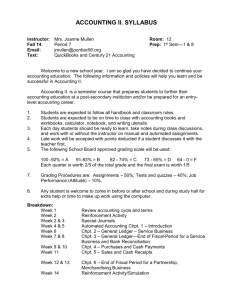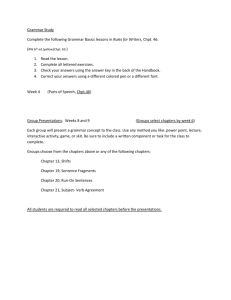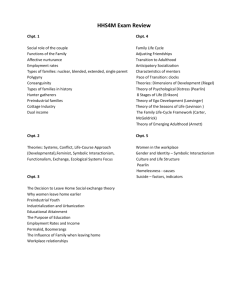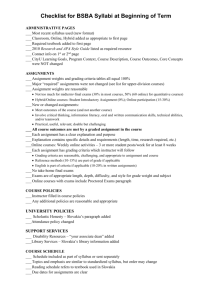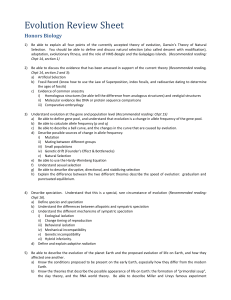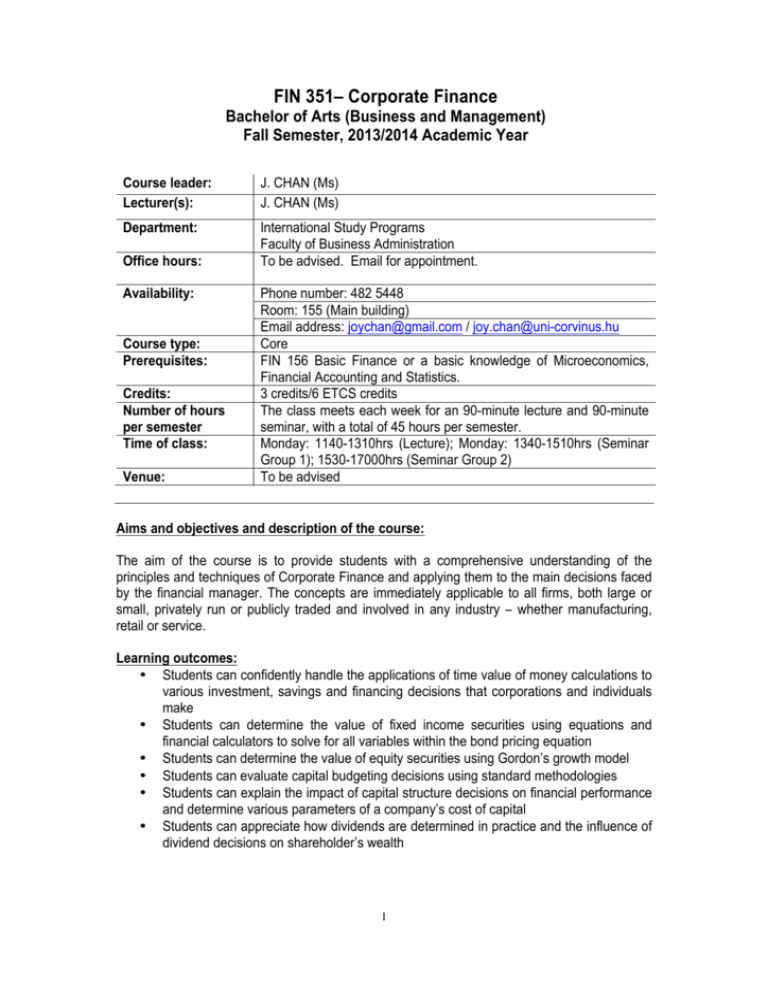
FIN 351– Corporate Finance
Bachelor of Arts (Business and Management)
Fall Semester, 2013/2014 Academic Year
Course leader:
Lecturer(s):
J. CHAN (Ms)
J. CHAN (Ms)
Department:
International Study Programs
Faculty of Business Administration
To be advised. Email for appointment.
Office hours:
Availability:
Course type:
Prerequisites:
Credits:
Number of hours
per semester
Time of class:
Venue:
Phone number: 482 5448
Room: 155 (Main building)
Email address: joychan@gmail.com / joy.chan@uni-corvinus.hu
Core
FIN 156 Basic Finance or a basic knowledge of Microeconomics,
Financial Accounting and Statistics.
3 credits/6 ETCS credits
The class meets each week for an 90-minute lecture and 90-minute
seminar, with a total of 45 hours per semester.
Monday: 1140-1310hrs (Lecture); Monday: 1340-1510hrs (Seminar
Group 1); 1530-17000hrs (Seminar Group 2)
To be advised
Aims and objectives and description of the course:
The aim of the course is to provide students with a comprehensive understanding of the
principles and techniques of Corporate Finance and applying them to the main decisions faced
by the financial manager. The concepts are immediately applicable to all firms, both large or
small, privately run or publicly traded and involved in any industry – whether manufacturing,
retail or service.
Learning outcomes:
• Students can confidently handle the applications of time value of money calculations to
various investment, savings and financing decisions that corporations and individuals
make
• Students can determine the value of fixed income securities using equations and
financial calculators to solve for all variables within the bond pricing equation
• Students can determine the value of equity securities using Gordon’s growth model
• Students can evaluate capital budgeting decisions using standard methodologies
• Students can explain the impact of capital structure decisions on financial performance
and determine various parameters of a company’s cost of capital
• Students can appreciate how dividends are determined in practice and the influence of
dividend decisions on shareholder’s wealth
1
Course description
The course is divided into 3 main sections, beginning with the concept of valuation where
topics covering time value of money and the valuation of income streams, share and bond
valuations will be discussed. The course will thereafter extend these principles in the second
section to provide an in-depth discussion and critical analysis of the various techniques used in
investment appraisal decisions: Net Present Value, Internal Rate of Return, Payback Period.
These techniques will be applied to more complex investment proposals, including choices
between alternative projects, investment timing decisions and decisions on whether to invest.
The final section explores the relationship between risk and return, diversifiable and nondiversifiable risks, and beta through the use of the Capital Asset Pricing Model (CAPM) to
determine the Weighted Average Cost of Capital that financial managers use as a hurdle rate
for project evaluation in order to achieve the ultimate aim of maximizing the value of the firm.
Methodology to be used:
All students should make an effort to read the required material before class as this would
enable you to make the most out of the lecture. All students are responsible for the material
covered in class, as well as the material in the handouts and required readings for each class,
regardless of whether they were able to attend the class.
Attendance is COMPULSORY for seminars and lectures. Missing 25% of the classes will
mean that you have failed the course (see ISP rules on class attendance).
There are 2 seminar groups for this course, and once students are assigned to the
respective seminar groups (by the ISP office), they are not allowed to switch between
the groups.
A problem set or case study will be assigned for home preparation each week. Students are
expected to read the assigned material, relevant sections of the textbook and prepare the
home assignment for discussion during the seminars (note that homework is graded).
Students are encouraged to participate actively in the discussion of the topics and numerical
problems. For any additional practice questions, you should refer to your problems and
question sets (with solutions) at the end of each chapter of your textbook.
My teaching is most effective when students actively participate in class. This means that
students must think along with me during class sessions. There must be substantial studentteacher interaction-- typically through student questions, comments, and answers to my
questions. Students should have a strong impact on the class session.
I expect all of us in the class to behave responsibly. Laptops/notebooks/Mobile phones &
devices cannot be used during classes. Students, who behave irresponsibly, imposing
costs on others (for example, talking in class or using the mobile devices continuously),
should expect to bear the consequences of their action. If the student persistently fails
to abide by the rules, he/she will be reported to the university administration and the
student will have to withdraw from the course with a fail grade (no exceptions will be
made on this).
Non-Programmable Financial calculators will be used in this course.
2
Detailed class schedule, 1st – 15th week:
Date of class
Week 1
9 Sep
Week 2
16 Sep
Week 3
23 Sep
Week 4
30 Sep
Week 5
7 Oct
Week 5
14 Oct
Week 6
21 Oct
Week 7
28 Oct
Week 8
4 Nov
Topics to be discussed, readings required for the class
Lecture 1: Introduction to Corporate Finance: Taking the mystery out
of Corporate Finance
- The Corporate firm and Goals of the firm
- Corporate securities as claims on the firm
- Financial markets
BD Chpt 1
Class Exercise
Lecture 2: Time value of Money I
- Review of time value of money concepts
- Present and Future values
- Annuities, Annuities Due, Perpetuities
BD Chpt 4
Class Exercise
Lecture 3: Time value of Money II
- Applications on Time value of Money concepts – retirement,
investments & savings
BD Chpt 4
Class Exercise
Lecture 4: Financial Statements Analysis
- Review of financial statements
- Financial statement analysis
BD Chpt 2
Class Exercise
Lecture 5: Bond Valuation
- Bond valuation calculations
- Bond pricing and risks
BD Chpt 8
Class Exercise
Lecture 6: Stock Valuation
- Stock valuation calculations
- Growth estimates, payout ratios and Return on Equity
BD Chpt 9
Class Exercise
Lecture 7: Risk & Return
- Risk free rates and risk premiums
- Betas and Capital Asset Pricing Model
BD Chpt 10 & 12
Class Exercise
Mid term exam (covering Lectures 1-6)
Review of mid term exam
Lecture 8: Corporate Investment Decisions using the Net Present
Value rule I
- Net Present Value
- Other methods for valuing investments: Internal Rate of Return,
Profitability Index, Payback Period
BD Chpt 6
3
Week 9
11 Nov
Week 10
18 Nov
Week 11 & 12
25 Nov & 2 Dec
Week 13
9 Dec
Week 14
16 Dec
Week 15
(Date be advised)
Class Exercise
Lecture 9: Corporate Investment Decisions using the Net Present
Value rule II
- Mutually Exclusive Projects and Project Interactions
- Equivalent Annual Cost and Capital Rationing
- Why NPV leads to better investment decisions than other criteria
BD Chpt 7; Keown Chpt 9
Class Exercise
Lecture 10: Corporate Investment Decisions using the Net Present
Value rule III
- Discounted and incremental cashflows
- Cashflows and inflation
BD Chpt 7
Class Exercise
DUE: Group report submission & Project presentation
Lecture 11: Cost of Capital and Capital structure
- Weighted average cost of capital
- Determining individual cost of capital
Keown Chpt 11
Class Exercise
Revision Lecture & Class Exercise
Comprehensive Final Exam (covering Lectures 1-11)
Assignments:
Group Project (20 points)
A group assignment will be handed to you in week 3 and you will be required to work in groups
of 4 or 5 and submit the findings in a hard-copy report submission as well as a group
presentation in Week 11. This report and presentation will comprise of 15 points and 5 points
respectively of your total grade. Each member of the group may be asked to assess each
other’s contribution to the group project and hence, the report grades may be scaled depending
on peer assessment. Presentation grades, however, will be individually assessed by the
instructor.
Proper referencing and plagiarism rules are strictly enforced for all written
assignments.
Assessment, grading:
The assessment for the course comprises of 4 parts, with the following weights:
10 points Home assignments & Class participation
20 points Project & Presentation (see above)
30 points Mid term exam
40 points Final exam *
Grading is based on the total score in line with standard grading patterns in the ISP. * To pass
the course, you will need to pass the final exam.
Final Exam (40 points) & Mid term Exam (30 points)
The dates for the exams are in accordance with the ISP academic calendar.
4
This course has ONLY one mid term and one final exam. The final exam is a closed-book
cumulative exam, covering the material expounded during the whole course. The grade
obtained for the course is marked against the standards of the ISP and as such, is final and
non-negotiable. No emails/conversations on trying to better your score will be entertained after
the exam.
You must take the exams during the allotted timeslots. Exams are scheduled well in
advance so that you can plan around these dates. Do not ask to be excused from exams
for matters of personal convenience. An unexcused absence without supporting
documentation (e.g., doctor’s note or police report) will result in an F grade.
According to Corvinus University regulations, there might be a RESIT exam. Do note that you
will have to take the FIRST SCHEDULED FINAL EXAM, and having failed it will you be
permitted to take the resit exam. The resit exam is comprehensive in its coverage and,
incrementally tougher (and it will replace all your earlier grades). The best grade you could
receive for a resit exam is a Grade C-.
The course grades will be curved based on relative performance if the class average is below
Hungarian Grade 3/ISP Grade C- (this is not likely). Otherwise a straight scale will be used with
the +/− system. You will be treated fairly in all matters pertaining to your grade.
Home assignments (5 points) and Class participation (5 points)
Home assignments will be distributed after each lecture. You will need to complete the home
assignments for submission in the next seminar class. All home assignments attempted will be
noted and this will comprise of 5 points. The rationale for assigning homework is that there is a
strong correlation between good grades and completing home assignments. Most students
who fail this course (usually about 10-15% of the students fail each semester) because
they do not attempt the assigned homework during the semester and instead, try to
cram in the week before the exams. This is a futile attempt. Finance cannot be learnt in a
week. You need be consistent in your study efforts throughout the entire semester. If you fail to
submit your home assignments on more than 3 occasions (unless you have a valid medical
reason with supporting documentation), you will obtain 0 points for your home assignment
grades.
Class participation comprises of 5 points. You can easily obtain 5 points if you offer your
solutions in class (by writing on the board), asking relevant questions, providing answers to
questions asked. Almost all participation noted by the instructor will increase the student’s class
participation grade, but negative class participation includes disrupting class (e.g. by
coming in late), talking in class, not paying attention during a student presentation,
other forms of rudeness toward your fellow students, and a lack of cooperation with
methods to ensure that no cheating occurs during exams will result in a deduction of
points (which might exceed 10 points depending on the extent of disruptive behavior).
Grading class participation is necessarily subjective and no subdivision of the grade will be
available to students.
Do note that the coursework component is a bonus to you and can significantly improve
your overall score. Most students who submit home assignments and participate in class will
obtain between 8-10 points. In similar vein, if you have not participated in class, you will obtain
a zero grade.
5
Do note that every point is earned, not negotiated.
Compulsory readings:
There are two textbooks used in this course:
Jonathan Berk & Peter DeMarzo, Corporate Finance –Global Second Edition (2010), Pearson
Addison-Wesley
Keown, Arthur J., Martin, John D., Petty, J.William, Scott, David F. Jr., Foundations of Finance
– 5th Edition, Prentice Hall, 2006
Lecturer’s Handouts
Video recording of Class lectures available at
http://ondemand.homburgacademy.org/course/corporate-finance/
Recommended readings:
Students could also use, as reference, R. Brealey and S. Myers, Principles of Corporate
Finance, McGraw-Hill, (or any other earlier/later editions of Brealey & Myers). This is a classic
textbook that everyone serious about a career in finance should own. It does an excellent job
explaining institutional details and established theories.
Students should read “The Wall Street Journal Europe,” “Financial Times,” “The Economist” or
other business publications every week, and look for real world examples that relate to class
topics.
Note: This syllabus is subject to revision before or during the course at the discretion of the instructor.
Hungarian and ECTS grading scale
Percentage achieved 87-­‐100 International grading scale
Hungarian ECTS Explanation for the Hungarian grade equivalent grade 5 A Excellent Percentage achieved 97-­‐100 International grade A+ 94-­‐96 A 77-­‐86 4 B Good 90-­‐93 A-­‐ 67-­‐76 3 C Satisfactory 87-­‐89 B+ 60-­‐66 2 D Pass 84-­‐86 B 0-­‐59 1 F Fail 80-­‐83 B-­‐ DNA Did not attend (no credit) 77-­‐79 C+ I C 70-­‐73 C-­‐ 67-­‐69 D+ Megtagadva R Incomplete (no credit) Signed (no credit) Refused (no credit) 74-­‐76 Nem jelent meg Nem vizsgázott Aláírva 64-­‐66 D 60-­‐63 D-­‐ 0-­‐59 F S 6

